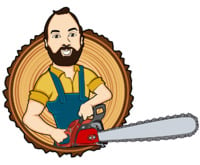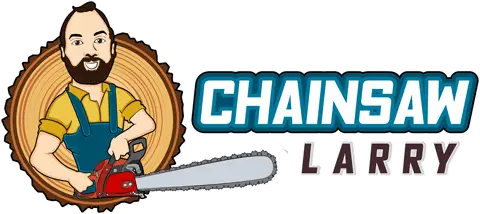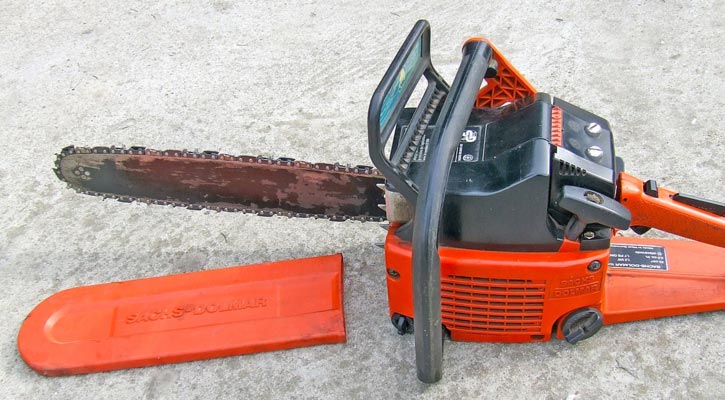Table of Contents
You couldn’t wait to get started on this new outdoor project…and then, suddenly your chainsaw doesn’t work as expected.
So you need to know how to fix a chainsaw fast, and want a good chainsaw troubleshooting guide that can help you get back to work.
Well, don’t worry.
Below, you’ll find my very best chainsaw troubleshooting tips that can help you fix your chainsaw so it’s running like new again.
Chainsaws of any type work better and last longer if maintained properly. Sometimes during your occasional chainsaw inspection, you might spot an issue like a blunt chain. However, not all chain problems are visible, especially if you’re a beginner.
There can be many reasons why you’re facing an issue with your chainsaw. That’s why I’ll walk you through the most common problems and more importantly, the solutions to fix a chainsaw.
You might be surprised but some of the most common chainsaw problems are not that difficult to fix. Even if you’re a beginner, you can do most of these repairs and troubleshooting yourself. Without the need of a professional!
In addition to this chainsaw troubleshooting guide, it’s always a good idea to check out the manual from your chainsaw manufacturer for detailed instructions on how to operate your chainsaw.
Sometimes a quick look at those pages can prevent damages that might lead to danger if not properly addressed.
Chainsaw Troubleshooting Guide
Chainsaw Won’t Start
Check the Spark Plug
Check to see if the spark plug is defective. You can remove it and figure out whether the porcelain is cracked, the electrode is damaged, or has a heavy carbon build-up. If any of these is the case, you should replace the spark plug.
Check the Carburetor
You should also check if the carburetor is clogged. Leaving fuel for a long time in the chainsaw can cause a clogged carburetor. This may prevent the engine from starting.
You can clean the carburetor with a can of carburetor cleaner or replace the component if the cleaning does not help.
Check the Ignition Coil
Another reason why the engine fails to start is because of a faulty ignition coil. The ignition coil transmits voltage to the spark plug when the engine is on. Ensure the spark plug is working properly before changing the ignition coil.
You can use an ignition coil tester for this chainsaw troubleshooting procedure.
Chainsaw Starts But Then Stalls
Check the Spark Arrestor
In order to solve this problem, you should check out the spark arrestor that prevents the engine from emitting sparks. Soot can clog the spark arrestor after a long time of using the chainsaw. As a result, the chainsaw may run rough or stall.
Remove and clean the spark arrestor with a wire brush or replace it if required.
Check the Air Filter
The air filter may be dirty or clogged. This causes the engine to have too much fuel and less air. Hence the engine will stall.
Check out the air filter to find out if it’s clogged and clean it. Otherwise, replace this filter with a new one.
Chainsaw is Running Rough
Check the Foam Filter
If your chainsaw is running rough, try checking out the foam filter. In most cases, it’s dirty or clogged. The solution to this problem is easy. You need to replace the foam filter.
Check the Fuel Filter
Another cause of your chainsaw running rough is a clogged fuel filter. Leaving old fuel in the chainsaw can cause a clogged fuel filter.
Some ingredients in the fuel evaporate and leave behind a thicker and stickier substance. This clogs up the fuel filter, and as a result, the engine runs rough.
When you replace the fuel filter be sure to also drain the old fuel and replace it with a fresh batch.
Chainsaw Chain is Not Turning
Check the Clutch
To troubleshoot this problem, you’ll want to look at the clutch. The clutch pads activate the clutch drum to rotate the chain. The motor will still run if the clutch pads are worn out but the clutch drum will not be engaged and the chain will not turn.
If the stop lever is engaged, the chain will not rotate. So disengage the stop lever. If you have worn out clutch pads, replace the whole clutch assembly.
Check the Clutch Band Drum Break
Another reason for the chain not turning could be the clutch band drum brake which activates the clutch drum to rotate the chain. If the clutch band is worn out, the motor will function but the clutch band will not activate the clutch drum.
As a result, the chain will not turn. Replace the clutch if it’s worn out.
Chainsaw Chain Won’t Stop Turning
Adjust the Carburetor
Upon finishing your work with the chainsaw and releasing the throttle, you should expect it to stop. But if it doesn’t, then you’ll want to look at the carburetor.
A simple solution would be a carburetor adjustment. A poor idle setting adjustment in the carburetor could be the problem. What happens is that fuel still flows in the combustion chamber upon releasing the throttle. Hence the engine does not stop.
To solve this problem you need to fix the idle screw on the carburetor. It’s located near the air filter. Turn the screw clockwise using a screwdriver to prevent fuel flow until the chain stops turning.
Ensure the chainsaw is running when you’re doing this troubleshooting procedure.
Replace the Clutch
Another reason why the chainsaw chain doesn’t stop turning could be due to broken springs or non-sticking clutch pads. The clutch drum is engaged by the clutch pads to rotate the chain.
If the springs are broken, the clutch pads won’t pull in and the chain will continue to turn. Sticking clutch pads keep the drum engaged and the chain doesn’t stop turning.
The solution is to fix the clutch assembly so that the chain turns properly again.
Chainsaw Won’t Cut
Replace or Sharpen the Chain
If your chainsaw is not cutting, it’s probably dull and needs to be replaced or sharpened.
When a chain is dull, it causes unnecessary wear and tears to the clutch, engine, and many other components. Why? Because the chain works harder to compromise the dullness.
One best way to sharpen a chainsaw is by mounting a file into a sharpening guide if you’re filing by hand.
Adjust the Chain
Another reason your chainsaw won’t cut might be that your chain is not properly adjusted. If the adjustment screw is loose, the chain could not be gripping the wood properly.
On the other hand, if the chain is very tight, it cannot be rotating at the proper speed. As a result, it doesn’t cut as expected and you’ll need to loosen the adjustment screw.
Replace the Guide Bar
If your chainsaw won’t cut, the chain bar could also be worn out. Normally, the chain should slide easily around the chain bar. If it doesn’t, then you may need to replace the guide bar.
When you’re using your chainsaw, always make sure that the oil reservoir is filled with bar oil. This is essential for keeping the bar well lubricated so that it doesn’t wear out.
Chainsaw Lacks Power
Check Various Components
If your chainsaw is experiencing power problems, you should check out the piston, muffler, cylinder, and spark plug for any wear. A plugged spark arrestor, muffler, or cylinder exhaust port will prevent the exhaust gases from leaving the engine and as a result, reduce engine power.
These crucial parts could be clogged with carbon and cleaning them can be a solution. You can also replace them if you want your chainsaw to ensure that your chainsaw is functioning most efficiently.
The piston and cylinder work together to facilitate combustion for powering the chainsaw. The ring in the piston can break off and fall, reducing its ability to create the necessary compression.
If that happens, then the chainsaw will not be running at its best and this will cause a lack of power. To repair this chainsaw problem, you’ll need to replace the ring or the piston and cylinder.
Chainsaw Engine Smokes
Having a smoking chainsaw can be bad news and delay your outdoor project. In most cases, something is wrong with the type of fuel you’re using or your chain bar is too hot.
To narrow down this chainsaw problem, check whether the smoke is coming from the engine or the chainsaw.
Check the Fuel
If the smoke comes from the engine, this is an immediate red flag since it can cause greater damage to the engine. This can be as a result of improperly mixed or contaminated fuel.
Fuel used in chainsaws is a mixture of oil and gasoline. The ratio of this mixture differs with different chainsaws but it’s usually 40:1 or 50:1. Check your chainsaw manual to ensure that you use the proper ratio.
Other things that could make your fuel go bad could be fuel containing water, dirt, or even wood particles.
Check the Oil Reservoir and Chain Tension
If the smoke comes from the chainsaw blade, then the chainsaw bar is not properly lubricated or there is a problem in the chainsaw chain tension.
Make sure that there’s enough oil in the guide bar oil reservoir. If not, then fill it up.
If the problem comes from the chainsaw chain tension, make sure that the chain is not too tight or too loose.
Chainsaw Chain is Clattering
Check the Bar and Chain
The clattering noise in the chain could be because of several factors like a twisted chain bar, a dull chain, and tension adjustment.
The good news is you can replace a twisted chain bar. To find the best chainsaw bar, look for the best length, gauge, weight, and pitch combination for the most efficient results.
If you’re wondering how to fix a chainsaw chain, sharpen the chain before use and whenever it gets dull. If it’s damaged, replace it with a new one.
Adjust the Tension of the Chain
The chain stretches out with time due to the constant friction and heat. Adjusting the chain regularly helps with the clattering. You’ll notice that the chain is too loose if it sags below the bar.
But don’t tighten the chain too much. The chain is too tight when you can’t pull it away slightly from the guide bar.
Check the Chainsaw Oil Level
The gasoline oil only lubricates the engine and not the chain. You can refer to the manual for oiling procedures. Some chainsaws have manual oilers while others have automatic oilers.
Make sure that the bar oil reservoir tank is full and use the best chainsaw oil for the bar like SAE 30 oil.
How to Fix a Chainsaw Summary
Most of the common chainsaw issues are easily resolved and preventable. If you buy a popular all around chainsaw with a great warranty and good reviews, you can rest assured that you’ll hardly come across any problems.
Taking good care of your chainsaw, proper maintenance, and following the manual requirements will help avoid the worst problems.
You’ll occasionally have some small wear and tear problems. But you can prevent many of them by keeping the most important parts in great condition so that you have to replace them less frequently.
Now, if you’re tired of using a gas-powered chainsaw and all the hassles that come with it, you can check out my electric chainsaw reviews guide or battery chainsaw reviews guide to find good tools that require less maintenance.
Or, if you want to see what the best chainsaws are of every type, then visit my top chainsaws reviews page to find out what’s available.
Either way, being aware of the most common chainsaw problems will prepare you for the inevitable and make it easy and quick to repair any issues or replace any faulty or worn out parts.
If you’re not experienced and not comfortable with how to fix a chainsaw yourself, you can always seek professional help. Most chainsaw repairs are easy, quick, and cheap.
I hope this article answered all of your questions about chainsaw troubleshooting tips.
Happy sawing!

Your pal,
Chainsaw Larry

